Not Just Fish
Aquarium life can be about a lot more than just fish. Like ponds and rivers and creeks, aquariums can be home to lots of different animals and plants.
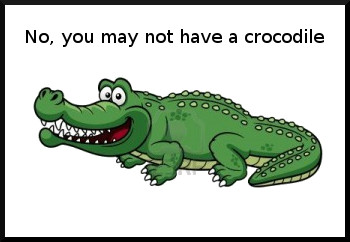 Of course, some things that live in rivers and lakes are not suitable for a home or school aquarium. Don't even think about keeping crocodiles!
Of course, some things that live in rivers and lakes are not suitable for a home or school aquarium. Don't even think about keeping crocodiles!
But there are certainly some interesting creatures that you can keep.
 The largest are amphibians. Although most amphibians need to come out on land when they are adults, you can enjoy their babies while they are still water animals. Collecting some tadpoles and watching them grow into frogs is pretty cool. Tadpoles are pretty easy to keep. You watch as they grow legs and lose their tail. At that stage, they need to be able to climb up our of the water on a rock or leaf. If you collected the tadpoles near your home or school, you can let the frogs go somewhere outside near water.
The largest are amphibians. Although most amphibians need to come out on land when they are adults, you can enjoy their babies while they are still water animals. Collecting some tadpoles and watching them grow into frogs is pretty cool. Tadpoles are pretty easy to keep. You watch as they grow legs and lose their tail. At that stage, they need to be able to climb up our of the water on a rock or leaf. If you collected the tadpoles near your home or school, you can let the frogs go somewhere outside near water.
There's one special amphibian that spends its whole life underwater. It is the Axolotyl or “Mexican Walking Fish” (and you are right, it isn't a fish at all).
Axolotls like deep, cool water. During a Canberra summer, they should be moved to an air-conditioned room or a few ice cubes should be placed daily in their tank. In captivity axolotls do well on live fish but will also thrive on pieces of meat, fish, prawns and earthworms. An albino form (white with pink eyes) is often available but remember that all albino forms of animals suffer 'discomfort under strong light. And with axolotls, remember to keep the water cold.
There's more interesting information about Axolotls here and here. In Canberra, you or your school will need a licence to keep an Axolotyl (but it is easy to get - there is no test!)
The other animals suitable for aquariums are invertebrates, like insects, snails, shrimp, prawns and yabbies. They can make interesting pets, although the insects, like tadpoles, do grow up and need to leave the aquarium.
Here's a few of these “mini beasts” you can try in your own tank.
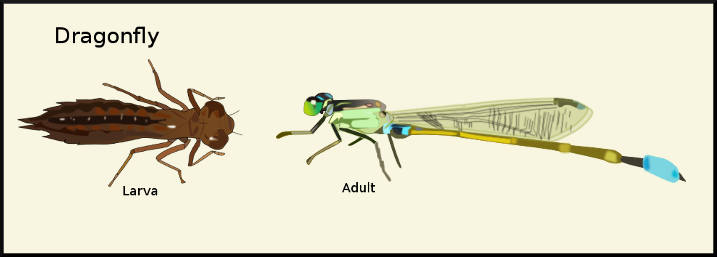
Name: Dragonfly Larvae
What are they? Insects. They are the baby form of the dragonfly.
Where to Find Them: on the bottom of rivers and lakes amongst the mud, stones and plants, usually in summer.
Warnings: They will eat small fish! They climb out of the water when they are ready to turn into dragonflies.

Name: Mayfly Nymphs
What are they? Insects. They are the baby form of the Mayfly. Look for the three tails.
Where to Find Them: on the bottom of rivers and lakes usually under stones. Look for them in Spring and Summer
Warnings: They are harmless but some fish do like to eat them. They climb out of the water when they are ready to turn into adult mayflies.
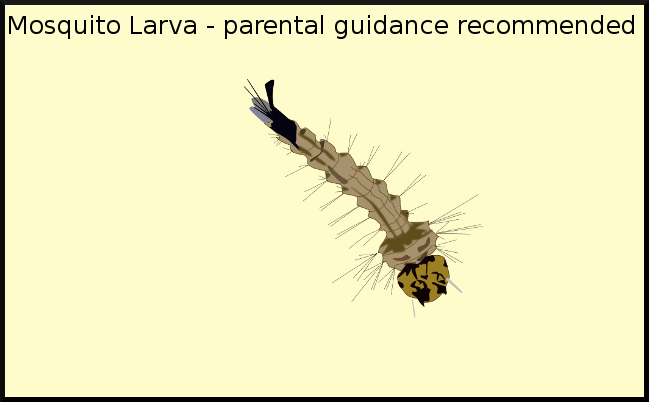
Name: Mosquito Larvae
What are they? Insects. They are the baby form of the Mosquito.
Where to Find Them: hanging upside down on the surface of still water. Look for them in Spring and Summer
Warnings: They turn into biting mosquitoes (parents and teachers might not be happy about having inside) Fish do like to eat them.

Name: Water snails
What are they? They are small snails that live underwater. There are lots of different types. They are from the Mollusc family.
Where to Find Them: On plants in rivers and lakes.
Warnings: They are generally harmless but some of them eat water plants.
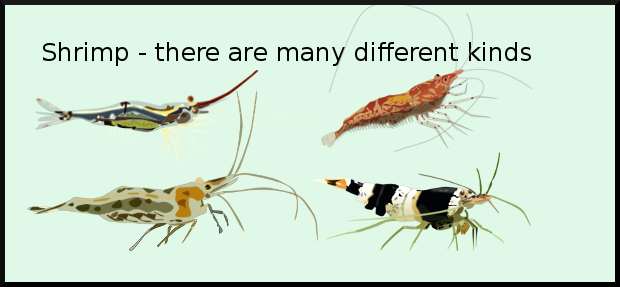
Name: Shrimp
What are they? Small crustaceans. There are many types and different colours.
Where to Find Them: On plants in rivers and lakes.
Warnings: They are generally harmless and quite interesting. Some fish will eat small shrimp.
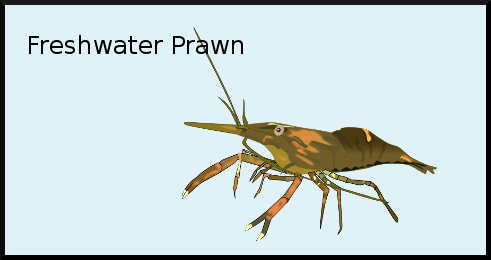
Name: Freshwater Prawns
What are they? Crustaceans. There are a few different types.
Where to Find Them: Mostly in rivers.
Warnings: They are generally harmless and quite interesting. They have long claws and may try to eat small fish.
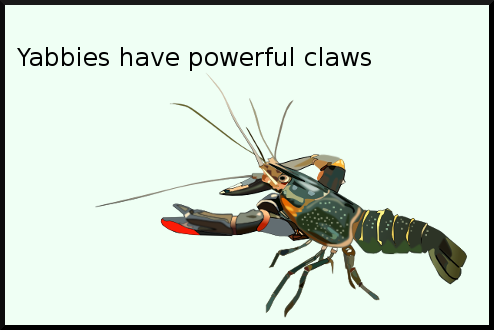
Name: Yabbies
What are they? Crustaceans. There are a few different types.
Where to Find Them: Mostly in rivers, lakes and farm dams.
Warnings: They can be aggressive. They have strong claws and may eat fish (and could nip you). They need caves to hide and will dig up plants. They can also escape from aquariums – you need a good lid.
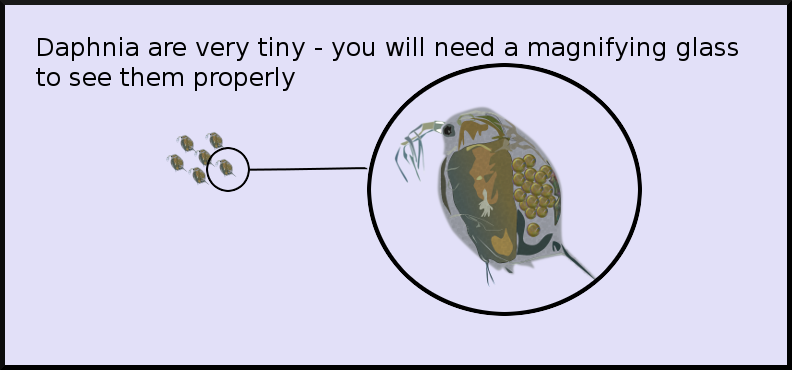
Name: Daphnia
What are they? Tiny crustaceans.
Where to Find Them: Mostly lakes and farm dams. They swim in the water. You need a fine net to catch them.
Warnings: They are a favorite food for small fish.
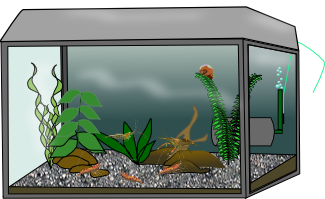 Like fish, these different creatures have different needs and not all of them can be kept together. If you collect your own from a local creek or lake, they probably won't need extra heating in their tank, but they may need a filter. Just be careful with the tiniest animals like shrimp and daphnia to make sure that they can't get sucked up into the filter. Using a sponge filter is a good idea for these little animals.
Like fish, these different creatures have different needs and not all of them can be kept together. If you collect your own from a local creek or lake, they probably won't need extra heating in their tank, but they may need a filter. Just be careful with the tiniest animals like shrimp and daphnia to make sure that they can't get sucked up into the filter. Using a sponge filter is a good idea for these little animals.
There are also tropical shrimp, water snails and freshwater prawns that do need heating. Sometimes these are available in aquarium shops or at club auctions. At least one mailorder business (Aquagreen) has some really interesting tropical varieties from the north of Australia.
You will also need to do a bit of research about what to feed them – although tadpoles, insect larvae, snails and shrimp mostly eat algae that will grow in your tank by itself. They will also eat a small amount of ordinary fish food.
You don't need a big tank to keep most of these creatures (except Yabbies). You can make the tank look nice and be a better home for your zoo with a few water plants and a light.
There are lots of other mini beasts that live in water. If you go collecting you might find some that are not mentioned here. Try to identify them and find out whether they can kept in your “Not-Just-Fish” tank.
